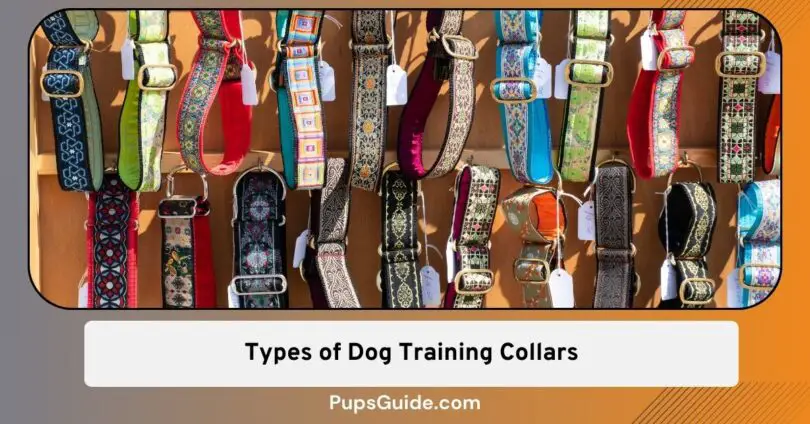When it comes to training your dog, choosing the right dog training collar can make all the difference in achieving a well-behaved and happy pup.
With a plethora of options available, it’s essential to understand the nuances of each collar type and how they can be effectively used in various training scenarios.
List of 10 Types of Dog Training Collars
Let’s find that out, all the while exploring their uses, benefits, and potential pitfalls.
1. Flat Collar:
The trusty flat collar, a staple in every dog owner’s collection, is primarily designed for identification purposes.
Lightweight and unobtrusive, it’s suitable for everyday wear. Use it when teaching your pup to associate wearing a collar with positive experiences, but avoid using it for correction-based training.
Misuse, such as leaving it too tight or attaching a leash without proper supervision, can lead to discomfort, chafing, or injury.
2. Martingale Collar:
Ideal for dogs with slender necks or those prone to slipping out of traditional collars, the Martingale collar provides a gentle way to prevent escape.
Use it during leash walks to discourage pulling without the harshness of a choke chain.
However, misuse involves excessive tightening, potentially causing discomfort or anxiety for your pup.
3. Prong Collar (Pinch Collar):
The prong collar, with its intimidating appearance, is designed to prevent pulling through discomfort rather than pain.
Effective for larger breeds, it requires careful handling. You should use it sparingly and under the guidance of a professional trainer.
Misuse, such as incorrect sizing or excessive force, can lead to physical harm, fear, and aggression in your dog.
4. Choke Chain:
A classic choice for traditional trainers, the choke chain tightens around the neck when the dog pulls. Using it cautiously during training exercises to correct pulling behaviors.
Misuse leads to harsh jerks, potentially causing injury to the trachea, neck, or thyroid. Overuse may lead to fear or anxiety in your dog.
5. Shock Collar (E-Collar):
The shock collar (shock collar vs bark collar) delivers an electric stimulus to get your dog’s attention. Effective for off-leash training, it should be used carefully and only after consultation with a professional trainer.
Misuse, such as using high-intensity shocks or applying them without proper training, can result in physical and psychological harm, eroding trust between you and your pet.
6. Citronella Collar:
For the barkers in the neighborhood, the citronella collar releases a burst of scent when activated. Many owners, including trainers like me, use it to discourage excessive barking without resorting to shocks.
Misuse includes fitting it too tightly or using it inconsistently, which may lead to your dog becoming desensitized to the scent or, conversely, developing anxiety.
7. Ultrasonic Collar:
Emitting a high-pitched sound when your dog barks, the ultrasonic collar is a more subtle alternative to shock collars.
They emulate the functionality of citronella collars but with a sound to deter barking without physical stimuli.
It’s not effective for all dogs, that’s one thing, but misuse could cause potential discomfort and even confusion.
8. Vibration Collar:
Much like citronella and ultrasonic collars, the vibration collars (how to use vibration collar to train dog) are also an alternative to shock collars. It uses the power of vibration for recall training or as a cue for specific behaviors.
Misuse involves overuse, leading to desensitization or confusion for your dog. You should pair vibrations with positive reinforcement to ensure a balanced training approach.
9. Head Collar (Halti or Gentle Leader):
Designed to control pulling, the head collar gently redirects your dog’s attention without causing discomfort.
We, trainers, use it as one of the preliminary ways to curb pulling in headstrong dogs as it gives you better control over their heads. Consequently, this can improve the dog’s off-leash behaviors.
Misuse includes fitting it too tightly or using excessive force, which may lead to discomfort or resistance from your dog.
10. Slip Collar (Martingale Chain):
Similar to the Martingale collar, the slip collar tightens when your dog pulls. It’s often used in training sessions for quick corrections.
Misuse involves continuous pressure or using it on a dog that is prone to anxiety, potentially exacerbating behavioral issues.
Why A Snug Fit Is Super Important for Any Collar Type?
Ensuring a snug fit for your dog’s training collar is vital, regardless of the type you choose. A proper fit not only ensures the effectiveness of the training but also safeguards your pet’s well-being and comfort.
The Flat Collar and Martingale Collar need to be tight enough to prevent accidental slips or escapes.
If too loose, your dog might easily maneuver out of the collar, putting them at risk of getting lost or injured. On the flip side, if too tight, these collars can cause discomfort, chafing, or even pose a risk to your dog’s health.
For collars like the Prong Collar, Choke Chain, and Shock Collar, a precise fit ensures proper functionality and avoids unnecessary harm.
A loose prong collar may fail to deliver the intended correction, while an overly tight one can cause pain, and injury, or instill fear in your pet.
Similarly, with choke chains, an incorrect fit can lead to choking hazards and potential injury to the neck.
The importance of a snug fit extends to collars like the Citronella Collar, Ultrasonic Collar, and Vibration Collar.
If these collars are not properly adjusted, they may not effectively deliver the intended stimuli or, conversely, cause unnecessary discomfort much like the rest of the collars.
Even for collars designed to control behavior without applying pressure, such as the Head Collar, a snug fit means a lot. It may slip off or fail to provide the necessary control during walks when it’s too loose.
On the other hand, a collar too tight can cause discomfort and resistance, making your dog less receptive to training.
Lastly, for the Slip Collar, a secure fit manages to ensure effective corrections without causing undue stress.
A well-fitted slip collar allows for quick adjustments and releases, ensuring timely corrections during training sessions. On the other hand, incorrect sizing may lead to constant pressure, potentially causing anxiety or fear in your dog.
A snug fit in each type of training collar is the linchpin for successful and humane training. Regularly check the fit of your dog’s collar, especially if they are still growing or if you switch between different collars for various training purposes.
Conclusion
Choosing the right one from the types of dog training collars involves understanding your pet’s temperament, and training goals, and seeking professional guidance.
While these tools can be effective when used correctly, misuse can lead to physical and psychological harm, eroding the trust and bond between you and your pet.
Always prioritize positive reinforcement, consistency, and patience in your training journey, ensuring a happy and well-behaved dog in the long run.








Leave a Comment